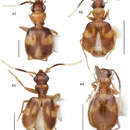Description
provided by Zookeys
(Figs 43, 67, 68). Habitus: (Fig. 43). Size: [See also Table 15] Medium-size for the genus; ABL = 2.894–2.995 mm, SBL = 2.501–2.598 mm, TW (total width) 1.325–1.490 mm, LP = 0.555–0.595 mm, WP = 0.638–0.691 mm, LE = 1.607–1.632 mm. Color: See diagnosis above. Luster: See diagnosis above. Head (Fig. 43): as in description for genus above. Prothorax. Pronotum (Fig. 43) moderately broad, slightly narrower than head across eyes (WH/WP, mean both sexes: 1.140), longer than head (LP/LH, mean both sexes: 1.586), about as longer than wide (WP/LP, mean both sexes: 1.157); markedly cordiform and convex lateral margin effaced with seta at anterior third on slightly raised area; apex markedly constricted; anterior angles feebly produced, hind angle slightly acutely produced and setose; median line feebly defined, basal transverse impressions punctate, punctures infuscated; surface smooth throughout. Pterothorax. Normal for genus, see description for genus above. Elytra moderately convex; at apical third twice as wide as head across eyes (WH/TW, mean both sexes: 0.535) and pronotum (WP/TW, mean both sexes: 0.469), longer than wide. Elytral interneurs effaced from most of the elytron surface, only evident as short discontinuous rows of coarse punctures, punctures with fuscous halo. Scattered fuscous punctures in the medial and apical quadrants present in some individuals. Hind wings fully developed. Legs. Overall, normal for genus, see description for genus above. Abdominal sterna. Overall, normal for genus, see description for genus above. Male genitalia (Figs 67, 68, see Fig. 61 for attribute labels). Median lobe with phallobase short about a fourth the length of shaft, basal opening small, oriented parallel to shaft. Shaft broad, slightly curved ventrally then curved dorsally near apex, dorsally sclerotized except for short ostium; in ventral aspect tapered toward rather broadly rounded apex, in lateral aspect, a narrowly rounded apex. Parameres: left very large and broad, right small and triangular; apex of left paramere narrowly rounded much longer than right paramere about half the length of shaft (measured in left lateral aspect). Endophallus with 2 preapical spines; we have illustrated an everted endophallus to demonstrate the location of the spines in a median field and an apical field. Female genitalia. Not investigated, presumably similar to that of Asklepia demiti sp. n.
- license
- cc-by-3.0
- copyright
- Terry L. Erwin, Laura S. Zamorano
- bibliographic citation
- Erwin T, Zamorano L (2014) A synopsis of the tribe Lachnophorini, with a new genus of Neotropical distribution and a revision of the Neotropical genus Asklepia Liebke, 1938 (Insecta, Coleoptera, Carabidae) ZooKeys 430: 1–108
- author
- Terry L. Erwin
- author
- Laura S. Zamorano
Distribution
provided by Zookeys
(Fig. 78). This species has been found at only one location on a lake shore near the white-water system of the Río Napo drainage system. But that does not at all indicate its real distribution: as has been pointed out above, very small beetles are inadequately sampled, especially in the Neotropics.
- license
- cc-by-3.0
- copyright
- Terry L. Erwin, Laura S. Zamorano
- bibliographic citation
- Erwin T, Zamorano L (2014) A synopsis of the tribe Lachnophorini, with a new genus of Neotropical distribution and a revision of the Neotropical genus Asklepia Liebke, 1938 (Insecta, Coleoptera, Carabidae) ZooKeys 430: 1–108
- author
- Terry L. Erwin
- author
- Laura S. Zamorano

